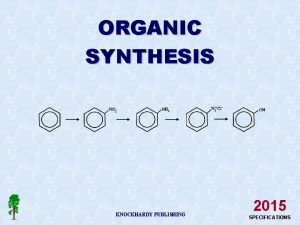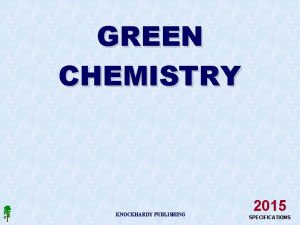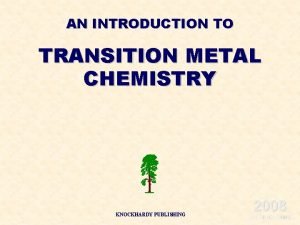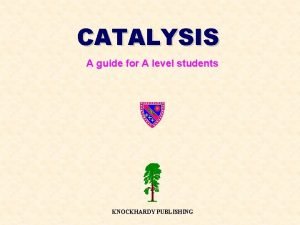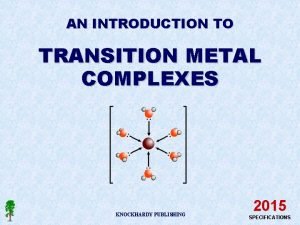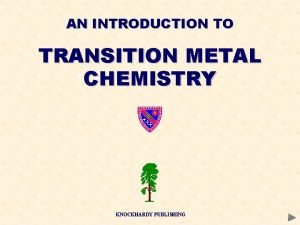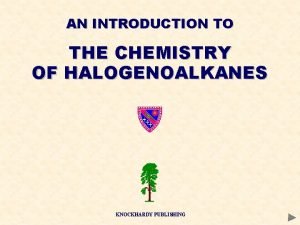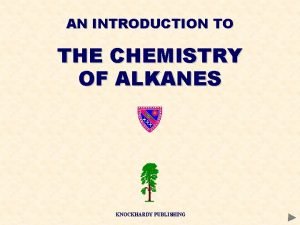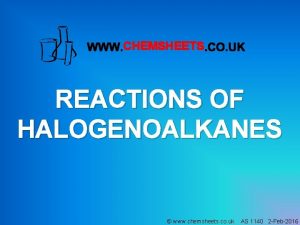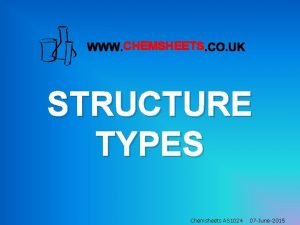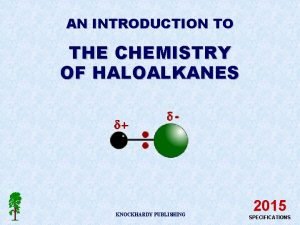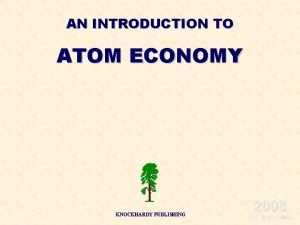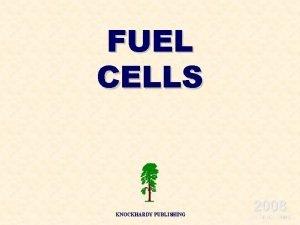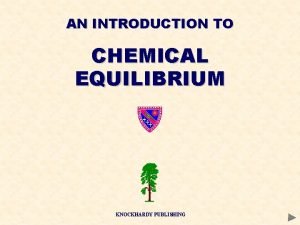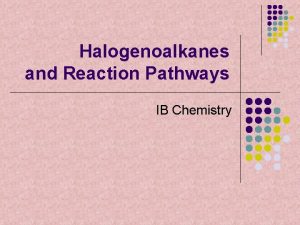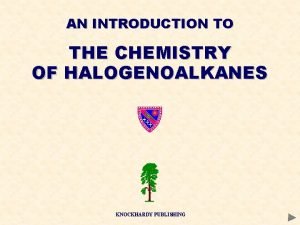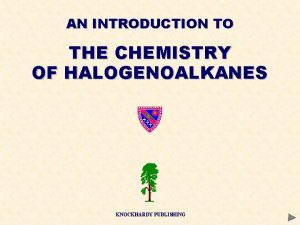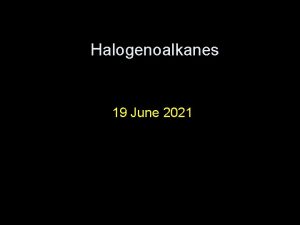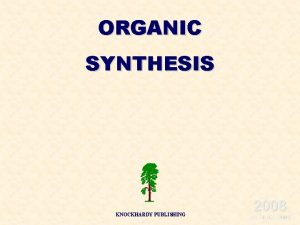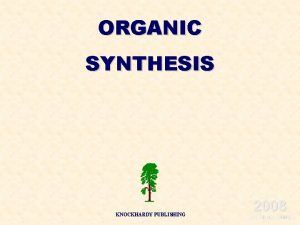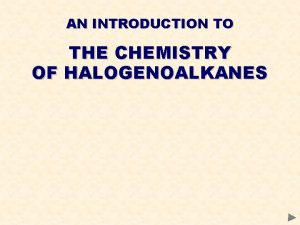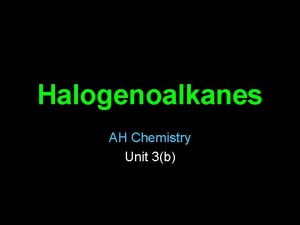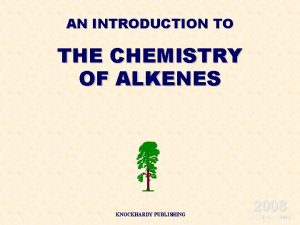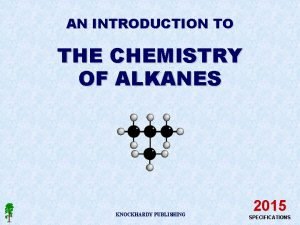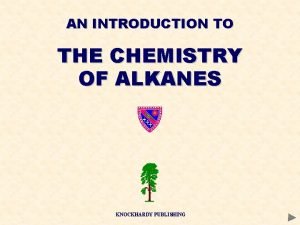AN INTRODUCTION TO THE CHEMISTRY OF HALOGENOALKANES KNOCKHARDY










































- Slides: 42

AN INTRODUCTION TO THE CHEMISTRY OF HALOGENOALKANES KNOCKHARDY PUBLISHING 2008 SPECIFICATIONS

KNOCKHARDY PUBLISHING THE CHEMISTRY OF HALOGENOALKANES INTRODUCTION This Powerpoint show is one of several produced to help students understand selected topics at AS and A 2 level Chemistry. It is based on the requirements of the AQA and OCR specifications but is suitable for other examination boards. Individual students may use the material at home for revision purposes or it may be used for classroom teaching if an interactive white board is available. Accompanying notes on this, and the full range of AS and A 2 topics, are available from the KNOCKHARDY SCIENCE WEBSITE at. . . www. knockhardy. org. uk/sci. htm Navigation is achieved by. . . either or clicking on the grey arrows at the foot of each page using the left and right arrow keys on the keyboard

THE CHEMISTRY OF HALOGENOALKANES CONTENTS • Structure of halogenoalkanes • Physical properties of halogenoalkanes • Nucleophilic substitution - theory • Nucleophilic substitution - examples • Substitution v. Elimination • Elimination reactions • Uses of haloalkanes • CFC’s • Revision check list

THE CHEMISTRY OF HALOGENOALKANES Before you start it would be helpful to… • Recall the definition of a covalent bond • Be able to balance simple equations • Be able to write out structures for hydrocarbons and their derivatives • Understand the different types of bond fission • Recall the chemical properties of alkanes, alkenes and alcohols

STRUCTURE OF HALOGENOALKANES Format Contain the functional group C-X where X is a halogen (F, Cl, Br or I) Halogenoalkanes - halogen is attached to an aliphatic skeleton - alkyl group Haloarenes - halogen is attached directly to a benzene (aromatic) ring

STRUCTURE OF HALOGENOALKANES Format Contain the functional group C-X where X is a halogen (F, Cl, Br or I) Halogenoalkanes - halogen is attached to an aliphatic skeleton - alkyl group Haloarenes Structural difference - halogen is attached directly to a benzene (aromatic) ring Halogenoalkanes are classified according to the environment of the halogen PRIMARY 1° SECONDARY 2° TERTIARY 3°

STRUCTURE OF HALOGENOALKANES Format Contain the functional group C-X where X is a halogen (F, Cl, Br or I) Halogenoalkanes - halogen is attached to an aliphatic skeleton - alkyl group Haloarenes Structural difference - halogen is attached directly to a benzene (aromatic) ring Halogenoalkanes are classified according to the environment of the halogen PRIMARY 1° Names SECONDARY 2° TERTIARY 3° Based on original alkane with a prefix indicating halogens and position. CH 3 CH 2 Cl 1 -chloropropane CH 3 CHCl. CH 3 2 -chloropropane CH 2 Cl. CH 3 1, 2 -dichloropropane CH 3 CBr(CH 3)CH 3 2 -bromo-2 -methylpropane

STRUCTURAL ISOMERISM IN HALOGENOALKANES Different structures are possible due to. . . Different positions for the halogen and branching of the carbon chain 1 -chlorobutane 2 -chloro-2 -methylpropane 2 -chlorobutane 1 -chloro-2 -methylpropane

PHYSICAL PROPERTIES Boiling point Increases with molecular size due to increased van der Waals’ forces Mr bp / °C chloroethane 64. 5 13 1 - chloropropane 78. 5 47 1 -bromopropane 124 71 Boiling point also increases for “straight” chain isomers. Greater branching = lower inter-molecular forces bp / °C 1 -bromobutane CH 3 CH 2 CH 2 Br 101 2 -bromobutane CH 3 CH 2 CHBr. CH 3 91 (CH 3)3 CBr 73 2 -bromo -2 -methylpropane Solubility Halogenoalkanes are soluble in organic solvents but insoluble in water

NUCLEOPHILIC SUBSTITUTION Theory • • • halogens have a greater electronegativity than carbon electronegativity is the ability to attract the shared pair in a covalent bond a dipole is induced in the C-X bond and it becomes polar the carbon is thus open to attack by nucleophiles nucleophile means ‘liking positive’ the greater electronegativity of the halogen attracts the shared pair of electrons so it becomes slightly negative; the bond is now polar.

NUCLEOPHILIC SUBSTITUTION Theory • • • halogens have a greater electronegativity than carbon electronegativity is the ability to attract the shared pair in a covalent bond a dipole is induced in the C-X bond and it becomes polar the carbon is thus open to attack by nucleophiles nucleophile means ‘liking positive’ the greater electronegativity of the halogen attracts the shared pair of electrons so it becomes slightly negative; the bond is now polar. NUCLEOPHILES • • • ELECTRON PAIR DONORS possess at least one LONE PAIR of electrons don’t have to possess a negative charge are attracted to the slightly positive (electron deficient) carbon examples are OH¯, CN¯, NH 3 and H 2 O (water is a poor nucleophile) OH¯ CN¯ NH 3 H 2 O

NUCLEOPHILIC SUBSTITUTION - MECHANISM the nucleophile uses its lone pair to provide the electrons for a new bond the halogen is displaced - carbon can only have 8 electrons in its outer shell the result is substitution following attack by a nucleophile the mechanism is therefore known as - NUCLEOPHILIC SUBSTITUTION

NUCLEOPHILIC SUBSTITUTION - MECHANISM the nucleophile uses its lone pair to provide the electrons for a new bond the halogen is displaced - carbon can only have 8 electrons in its outer shell the result is substitution following attack by a nucleophile the mechanism is therefore known as - NUCLEOPHILIC SUBSTITUTION Points the nucleophile has a lone pair of electrons the carbon-halogen bond is polar a ‘curly arrow’ is drawn from the lone pair to the slightly positive carbon atom a ‘curly arrow’ is used to show the movement of a pair of electrons carbon is restricted to 8 electrons in its outer shell - a bond must be broken the polar carbon-halogen bond breaks heterolytically (unevenly) the second ‘curly arrow’ shows the shared pair moving onto the halogen now has its own electron back plus that from the carbon atom it now becomes a negatively charged halide ion a halide ion (the leaving group) is displaced

NUCLEOPHILIC SUBSTITUTION - MECHANISM the nucleophile uses its lone pair to provide the electrons for a new bond the halogen is displaced - carbon can only have 8 electrons in its outer shell the result is substitution following attack by a nucleophile the mechanism is therefore known as - NUCLEOPHILIC SUBSTITUTION ANIMATION SHOWING THE SN 2 MECHANISM

NUCLEOPHILIC SUBSTITUTION - MECHANISM the nucleophile uses its lone pair to provide the electrons for a new bond the halogen is displaced - carbon can only have 8 electrons in its outer shell the result is substitution following attack by a nucleophile the mechanism is therefore known as - NUCLEOPHILIC SUBSTITUTION ANIMATION SHOWING THE SN 2 MECHANISM

NUCLEOPHILIC SUBSTITUTION - RATE OF REACTION Basics An important reaction step is the breaking of the carbon-halogen (C-X) bond The rate of reaction depends on the strength of the C-X bond C-I 238 k. Jmol-1 C-Br 276 k. Jmol-1 C-Cl 338 k. Jmol-1 C-F 484 k. Jmol-1 weakest - easiest to break strongest - hardest to break

NUCLEOPHILIC SUBSTITUTION - RATE OF REACTION Basics An important reaction step is the breaking of the carbon-halogen (C-X) bond The rate of reaction depends on the strength of the C-X bond Experiment C-I 238 k. Jmol-1 C-Br 276 k. Jmol-1 C-Cl 338 k. Jmol-1 C-F 484 k. Jmol-1 weakest - easiest to break strongest - hardest to break Water is a poor nucleophile but it can slowly displace halide ions C 2 H 5 Br(l) + H 2 O(l) ——> C 2 H 5 OH(l) + H+ (aq) + Br¯(aq) If aqueous silver nitrate is shaken with a halogenoalkane (they are immiscible) the displaced halide combines with a silver ion to form a precipitate of a silver halide. The weaker the C-X bond the quicker the precipitate appears. Ag+ (aq) + X¯(aq) ——> Ag. X(s) Ag. Cl white ppt Ag. Br cream ppt Ag. I yellow ppt

NUCLEOPHILIC SUBSTITUTION - RATE OF REACTION Basics An important reaction step is the breaking of the carbon-halogen (C-X) bond The rate of reaction depends on the strength of the C-X bond Experiment C-I 238 k. Jmol-1 C-Br 276 k. Jmol-1 C-Cl 338 k. Jmol-1 C-F 484 k. Jmol-1 weakest - easiest to break strongest - hardest to break Water is a poor nucleophile but it can slowly displace halide ions C 2 H 5 Br(l) + H 2 O(l) ——> C 2 H 5 OH(l) + H+ (aq) + Br¯(aq) If aqueous silver nitrate is shaken with a halogenoalkane (they are immiscible) the displaced halide combines with a silver ion to form a precipitate of a silver halide. The weaker the C-X bond the quicker the precipitate appears. Advanced This form of nucleophilic substitution is known as SN 2; it is a bimolecular process. work An alternative method involves the initial breaking of the C-X bond to form a carbocation, or carbonium ion, (a unimolecular process - SN 1 mechanism), which is then attacked by the nucleophile. SN 1 is favoured for tertiary haloalkanes where there is steric hindrance to the attack and a more stable tertiary, 3°, carbocation intermediate is formed.

NUCLEOPHILIC SUBSTITUTION AQUEOUS SODIUM HYDROXIDE Reagent Conditions Product Nucleophile Equation Aqueous* sodium (or potassium) hydroxide Reflux in aqueous solution (SOLVENT IS IMPORTANT) Alcohol hydroxide ion (OH¯) e. g. C 2 H 5 Br(l) + Na. OH(aq) ——> C 2 H 5 OH(l) + Na. Br(aq) Mechanism * WARNING It is important to quote the solvent when answering questions. Elimination takes place when ethanol is the solvent - SEE LATER The reaction (and the one with water) is known as HYDROLYSIS

NUCLEOPHILIC SUBSTITUTION AQUEOUS SODIUM HYDROXIDE ANIMATED MECHANISM

NUCLEOPHILIC SUBSTITUTION POTASSIUM CYANIDE Reagent Conditions Product Nucleophile Equation Mechanism Aqueous, alcoholic potassium (or sodium) cyanide Reflux in aqueous , alcoholic solution Nitrile (cyanide) cyanide ion (CN¯) e. g. C 2 H 5 Br + KCN (aq/alc) ——> C 2 H 5 CN + KBr(aq)

NUCLEOPHILIC SUBSTITUTION POTASSIUM CYANIDE Reagent Conditions Product Nucleophile Equation Aqueous, alcoholic potassium (or sodium) cyanide Reflux in aqueous , alcoholic solution Nitrile (cyanide) cyanide ion (CN¯) e. g. C 2 H 5 Br + KCN (aq/alc) ——> C 2 H 5 CN + KBr(aq) Mechanism Importance extends the carbon chain by one carbon atom the CN group can be converted to carboxylic acids or amines. Hydrolysis C 2 H 5 CN + 2 H 2 O Reduction C 2 H 5 CN + 4[H] ———> C 2 H 5 COOH + ———> C 2 H 5 CH 2 NH 2 NH 3

NUCLEOPHILIC SUBSTITUTION POTASSIUM CYANIDE ANIMATED MECHANISM

NUCLEOPHILIC SUBSTITUTION AMMONIA Reagent Conditions Product Nucleophile Equation Aqueous, alcoholic ammonia (in EXCESS) Reflux in aqueous , alcoholic solution under pressure Amine Ammonia (NH 3) e. g. C 2 H 5 Br + 2 NH 3 (aq / alc) ——> C 2 H 5 NH 2 + NH 4 Br (i) C 2 H 5 Br + (ii) HBr NH 3 (aq / alc) + NH 3 (aq / alc) ——> C 2 H 5 NH 2 + HBr ——> NH 4 Br Mechanism Notes The equation shows two ammonia molecules. The second one ensures that a salt is not formed.

NUCLEOPHILIC SUBSTITUTION AMMONIA Why excess ammonia? The second ammonia molecule ensures the removal of HBr which would lead to the formation of a salt. A large excess ammonia ensures that further substitution doesn’t take place - see below Problem Amines are also nucleophiles (lone pair on N) and can attack another molecule of halogenoalkane to produce a 2° amine. This too is a nucleophile and can react further producing a 3° amine and, eventually an ionic quarternary ammonium salt. C 2 H 5 NH 2 + C 2 H 5 Br ——> HBr + (C 2 H 5)2 NH + C 2 H 5 Br ——> HBr + (C 2 H 5)3 N + C 2 H 5 Br ——> (C 2 H 5)4 N+ Br¯ diethylamine, a 2° amine triethylamine, a 3° amine tetraethylammonium bromide a quaternary (4°) salt

NUCLEOPHILIC SUBSTITUTION WATER Details A similar reaction to that with OH¯ takes place with water. It is slower as water is a poor nucleophile. Equation C 2 H 5 Br(l) + H 2 O(l) ——> C 2 H 5 OH(l) + HBr(aq)

ELIMINATION v. SUBSTITUTION The products of reactions between haloalkanes and OH¯ are influenced by the solvent SOLVENT ROLE OF OH– MECHANISM PRODUCT WATER NUCLEOPHILE SUBSTITUTION ALCOHOL BASE ELIMINATION ALKENE Modes of attack Aqueous soln OH¯ attacks the slightly positive carbon bonded to the halogen. OH¯ acts as a nucleophile Alcoholic soln OH¯ attacks one of the hydrogen atoms on a carbon atom adjacent the carbon bonded to the halogen. OH¯ acts as a base (A BASE IS A PROTON ACCEPTOR) Both reactions take place at the same time but by varying the solvent you can influence which mechanism dominates.

ELIMINATION Reagent Conditions Product Mechanism Equation Alcoholic sodium (or potassium) hydroxide Reflux in alcoholic solution Alkene Elimination C 3 H 7 Br + Na. OH(alc) ——> C 3 H 6 + H 2 O + Na. Br Mechanism the OH¯ ion acts as a base and picks up a proton the proton comes from a carbon atom next to that bonded to the halogen the electron pair left moves to form a second between the carbon atoms the halogen is displaced overall there is ELIMINATION of HBr. Complication With unsymmetrical halogenoalkanes, you can get mixture of products

ELIMINATION ANIMATED MECHANISM

ELIMINATION Complication The OH¯ removes a proton from a carbon atom adjacent the C bearing the halogen. If there had been another carbon atom on the other side of the C-Halogen bond, its hydrogen(s) would also be open to attack. If the haloalkane is unsymmetrical (e. g. 2 bromobutane) a mixture of isomeric alkene products is obtained. but-1 -ene but-2 -ene can exist as cis and trans isomers

USES OF HALOGENOALKANES Synthetic The reactivity of the C-X bond means that halogenoalkanes play an important part in synthetic organic chemistry. The halogen can be replaced by a variety of groups via nucleophilic substitution.

USES OF HALOGENOALKANES Synthetic The reactivity of the C-X bond means that halogenoalkanes play an important part in synthetic organic chemistry. The halogen can be replaced by a variety of groups via nucleophilic substitution. Polymers Many useful polymers are formed from halogeno hydrocarbons Monomer chloroethene Polymer poly(chloroethene) PVC Repeating unit - (CH 2 - CHCl)n – USED FOR PACKAGING tetrafluoroethene poly(tetrafluoroethene) PTFE - (CF 2 - CF 2)n USED FOR NON-STICK SURFACES

USES OF HALOGENOALKANES Synthetic The reactivity of the C-X bond means that halogenoalkanes play an important part in synthetic organic chemistry. The halogen can be replaced by a variety of groups via nucleophilic substitution. Polymers Many useful polymers are formed from halogeno hydrocarbons Monomer chloroethene Polymer Repeating unit poly(chloroethene) PVC - (CH 2 - CHCl)n – USED FOR PACKAGING tetrafluoroethene Chlorofluorocarbons - CFC’s dichlorofluoromethane trichlorofluoromethane bromochlorodifluoromethane poly(tetrafluoroethene) PTFE - (CF 2 - CF 2)n USED FOR NON-STICK SURFACES CHFCl 2 CF 3 Cl CBr. Cl. F 2 CCl 2 FCCl. F 2 All are/were chosen because of their refrigerant aerosol propellant, blowing agent fire extinguishers dry cleaning solvent, degreasing agent LOW REACTIVITY, VOLATILITY, NON-TOXICITY

USES OF HALOGENOALKANES Synthetic The reactivity of the C-X bond means that halogenoalkanes play an important part in synthetic organic chemistry. The halogen can be replaced by a variety of groups via nucleophilic substitution. Polymers Many useful polymers are formed from halogeno hydrocarbons Monomer chloroethene Polymer Repeating unit poly(chloroethene) PVC - (CH 2 - CHCl)n – USED FOR PACKAGING tetrafluoroethene Chlorofluorocarbons - CFC’s dichlorofluoromethane trichlorofluoromethane bromochlorodifluoromethane poly(tetrafluoroethene) PTFE - (CF 2 - CF 2)n USED FOR NON-STICK SURFACES CHFCl 2 CF 3 Cl CBr. Cl. F 2 CCl 2 FCCl. F 2 All are/were chosen because of their refrigerant aerosol propellant, blowing agent fire extinguishers dry cleaning solvent, degreasing agent LOW REACTIVITY, VOLATILITY, NON-TOXICITY

PROBLEMS WITH CFC’s AND THE OZONE LAYER CFC’s have been blamed for damage to the environment by thinning the ozone layer Ozone absorbs a lot of harmful UV radiation However it breaks down more easily in the presence of CFC's CFC’s break up in the atmosphere to form radicals Free radicals catalyse the breaking up of ozone CF 2 Cl 2 ——> CF 2 Cl • + Cl • 2 O 3 ——> 3 O 2

PROBLEMS WITH CFC’s AND THE OZONE LAYER CFC’s have been blamed for damage to the environment by thinning the ozone layer Ozone absorbs a lot of harmful UV radiation However it breaks down more easily in the presence of CFC's CFC’s break up in the atmosphere to form radicals Free radicals catalyse the breaking up of ozone CF 2 Cl 2 ——> CF 2 Cl • + Cl • 2 O 3 ——> 3 O 2 CFC’s were designed by chemists to help people Chemists are now having to synthesise alternatives to CFC’s to protect the environment - Hydrocarbons and HCFC’s are used for propellants - CO 2 can be used as a blowing agent for making expanded polystyrene This will allow the reversal of the ozone layer problem

PROBLEMS WITH CFC’s AND THE OZONE LAYER CFC’s have been blamed for damage to the environment by thinning the ozone layer Ozone absorbs a lot of harmful UV radiation However it breaks down more easily in the presence of CFC's CFC’s break up in the atmosphere to form radicals Free radicals catalyse the breaking up of ozone CF 2 Cl 2 ——> CF 2 Cl • + Cl • 2 O 3 ——> 3 O 2 CFC’s were designed by chemists to help people Chemists are now having to synthesise alternatives to CFC’s to protect the environment - Hydrocarbons and HCFC’s are used for propellants - CO 2 can be used as a blowing agent for making expanded polystyrene This will allow the reversal of the ozone layer problem

PROBLEMS WITH CFC’s AND THE OZONE LAYER There is a series of complex reactions but the basic process is : • ozone in the atmosphere breaks down naturally • CFC's break down in UV light to form radicals O 3 ——> O + CCl 2 F 2 ——> Cl • + O 2 CCl. F 2 • • chlorine radicals then react with ozone O 3 + Cl • ——> Cl. O • + O 2 • chlorine radicals are regenerated Cl. O • + O ——> O 2 + Cl • Overall, chlorine radicals are not used up so a small amount of CFC's can destroy thousands of ozone molecules before they take part in a termination stage.

REVISION CHECK What should you be able to do? Recall and explain the physical properties of halogenoalkanes Recall and explain the chemical properties of halogenoalkanes based on their structure Recall and explain the properties of nucleophiles Write balanced equations for reactions involving substitution and elimination Understand how the properties of a hydroxide ion are influenced by the choice of solvent Recall the effect of CFC’s on the ozone layer CAN YOU DO ALL OF THESE? YES NO

You need to go over the relevant topic(s) again Click on the button to return to the menu

WELL DONE! Try some past paper questions

AN INTRODUCTION TO THE CHEMISTRY OF HALOGENOALKANES THE END © 2009 JONATHAN HOPTON & KNOCKHARDY PUBLISHING
 Knockhardy publishing
Knockhardy publishing Knockhardy chemistry
Knockhardy chemistry Knockhardy publishing
Knockhardy publishing Knockhardy a level chemistry
Knockhardy a level chemistry Knockhardy
Knockhardy Knockhardy a level chemistry
Knockhardy a level chemistry Knockhardy chemistry
Knockhardy chemistry Knockhardy chemistry
Knockhardy chemistry Knockhardy chemistry
Knockhardy chemistry Substitution of halogenoalkane with aqueous naoh
Substitution of halogenoalkane with aqueous naoh Knockhardy chemistry
Knockhardy chemistry Reactions of alkenes 1 chemsheets answers
Reactions of alkenes 1 chemsheets answers Chemsheets as 1017 shapes of molecules
Chemsheets as 1017 shapes of molecules Br2 color
Br2 color Knockhardy
Knockhardy Atom economy
Atom economy Knockhardy notes
Knockhardy notes Knockhardy gcse
Knockhardy gcse Enthalpy change of combustion definition a level
Enthalpy change of combustion definition a level Knockhardy gcse
Knockhardy gcse Knockhardy gcse
Knockhardy gcse Knockhardy notes
Knockhardy notes Knockhardy ppt
Knockhardy ppt Knockhardy publishing
Knockhardy publishing Ib chemistry organic chemistry
Ib chemistry organic chemistry Organic vs inorganic chemistry
Organic vs inorganic chemistry Hát kết hợp bộ gõ cơ thể
Hát kết hợp bộ gõ cơ thể Ng-html
Ng-html Bổ thể
Bổ thể Tỉ lệ cơ thể trẻ em
Tỉ lệ cơ thể trẻ em Gấu đi như thế nào
Gấu đi như thế nào Glasgow thang điểm
Glasgow thang điểm Bài hát chúa yêu trần thế alleluia
Bài hát chúa yêu trần thế alleluia Kể tên các môn thể thao
Kể tên các môn thể thao Thế nào là hệ số cao nhất
Thế nào là hệ số cao nhất Các châu lục và đại dương trên thế giới
Các châu lục và đại dương trên thế giới Công thức tính thế năng
Công thức tính thế năng Trời xanh đây là của chúng ta thể thơ
Trời xanh đây là của chúng ta thể thơ Cách giải mật thư tọa độ
Cách giải mật thư tọa độ 101012 bằng
101012 bằng độ dài liên kết
độ dài liên kết Các châu lục và đại dương trên thế giới
Các châu lục và đại dương trên thế giới Thể thơ truyền thống
Thể thơ truyền thống

